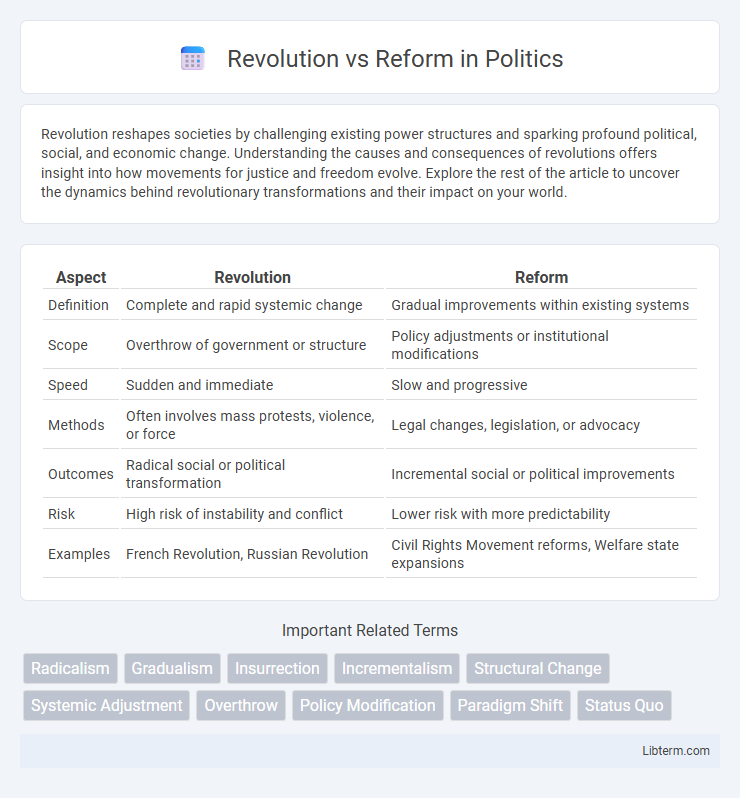Revolution reshapes societies by challenging existing power structures and sparking profound political, social, and economic change. Understanding the causes and consequences of revolutions offers insight into how movements for justice and freedom evolve. Explore the rest of the article to uncover the dynamics behind revolutionary transformations and their impact on your world.
Table of Comparison
| Aspect | Revolution | Reform |
|---|---|---|
| Definition | Complete and rapid systemic change | Gradual improvements within existing systems |
| Scope | Overthrow of government or structure | Policy adjustments or institutional modifications |
| Speed | Sudden and immediate | Slow and progressive |
| Methods | Often involves mass protests, violence, or force | Legal changes, legislation, or advocacy |
| Outcomes | Radical social or political transformation | Incremental social or political improvements |
| Risk | High risk of instability and conflict | Lower risk with more predictability |
| Examples | French Revolution, Russian Revolution | Civil Rights Movement reforms, Welfare state expansions |
Understanding Revolution and Reform
Revolution involves a rapid, fundamental change in political, social, or economic structures, often through upheaval or conflict, aiming to replace existing systems entirely. Reform seeks gradual, systematic improvements within existing institutions, focusing on modifying laws, policies, or practices to address injustices or inefficiencies. Understanding the distinction highlights how revolutions disrupt established order, while reforms work within it to achieve progress.
Historical Contexts of Revolution
Revolutions historically emerge during periods of intense social, economic, and political crisis, often marked by widespread dissatisfaction with existing regimes, such as the French Revolution of 1789 or the Russian Revolution of 1917. They involve rapid, fundamental changes aimed at overthrowing ruling authorities and radically restructuring societal institutions. Unlike gradual reforms, revolutions typically result from acute conflicts and can lead to significant shifts in power dynamics and governance structures.
Key Characteristics of Reform
Reform is characterized by gradual, systematic changes within existing political or social structures, aiming to improve rather than overthrow the system. It typically involves legal adjustments, policy modifications, and institutional amendments driven by consensus and dialogue. Reform prioritizes stability, continuity, and incremental progress, often utilizing established democratic processes and mechanisms for implementation.
Causes Driving Revolutionary Movements
Revolutionary movements are driven by deep-rooted social inequalities, economic hardships, and political oppression that fuel widespread dissatisfaction among the populace. Systemic failures such as corruption, lack of representation, and denial of basic rights create conditions ripe for radical change rather than gradual improvement. These causes distinguish revolutionary movements from reform efforts, which typically aim to adjust or improve existing structures within the status quo.
Motivations Behind Reform Efforts
Reform efforts are primarily motivated by the desire to address specific social, political, or economic injustices within the existing system without dismantling it entirely. Advocates seek gradual improvements, aiming to create change through policy adjustments, legal amendments, or institutional reforms that maintain stability and continuity. These motivations contrast with revolutionary impulses, which often stem from systemic dissatisfaction and the belief that fundamental transformation is necessary.
Comparing Impacts: Revolution vs. Reform
Revolutions often produce rapid, sweeping changes by overthrowing existing political and social structures, leading to significant disruptions and reconfigurations of power. Reforms, in contrast, implement gradual adjustments within the established system, promoting stability and continuity while addressing specific issues incrementally. The impact of revolutions tends to be more radical and immediate, whereas reforms foster long-term transformation through policy evolution and institutional adaptation.
Success Stories: Revolutionary Change
Revolutionary change has led to profound transformations in countries like France, Russia, and China, where radical shifts dismantled existing regimes to establish new political and social orders. The American Revolution successfully replaced colonial rule with an independent democratic government, inspiring global movements for freedom. Key success factors in these revolutions include mass mobilization, clear ideological goals, and the ability to sustain momentum against entrenched powers.
Notable Reforms That Shaped Society
Notable reforms that shaped society include the abolition of slavery, women's suffrage, and labor laws establishing fair working conditions. These reforms fundamentally altered social structures by promoting equality and human rights without overthrowing existing political systems. Educational reforms and civil rights movements also played critical roles in advancing justice and inclusivity within established frameworks.
Challenges and Risks of Each Approach
Revolution often entails abrupt systemic change, posing significant risks such as political instability, economic disruption, and potential violence that can undermine social cohesion. Reform offers a gradual transformation within existing structures, but it faces challenges like entrenched resistance from vested interests and slow progress that may fail to address urgent societal needs. Both strategies demand careful consideration of context-specific factors to balance the urgency of change with the potential consequences for governance and public order.
The Future: Choosing Between Revolution and Reform
The future hinges on the strategic choice between revolution and reform, where revolution offers rapid systemic change but risks instability, while reform ensures gradual improvement within existing frameworks. Societies must evaluate economic, social, and political factors to determine whether profound disruption or incremental adaptation better serves long-term goals. Emphasizing sustainable development and social equity drives the decision towards either transformative upheaval or measured progress.
Revolution Infographic

 libterm.com
libterm.com